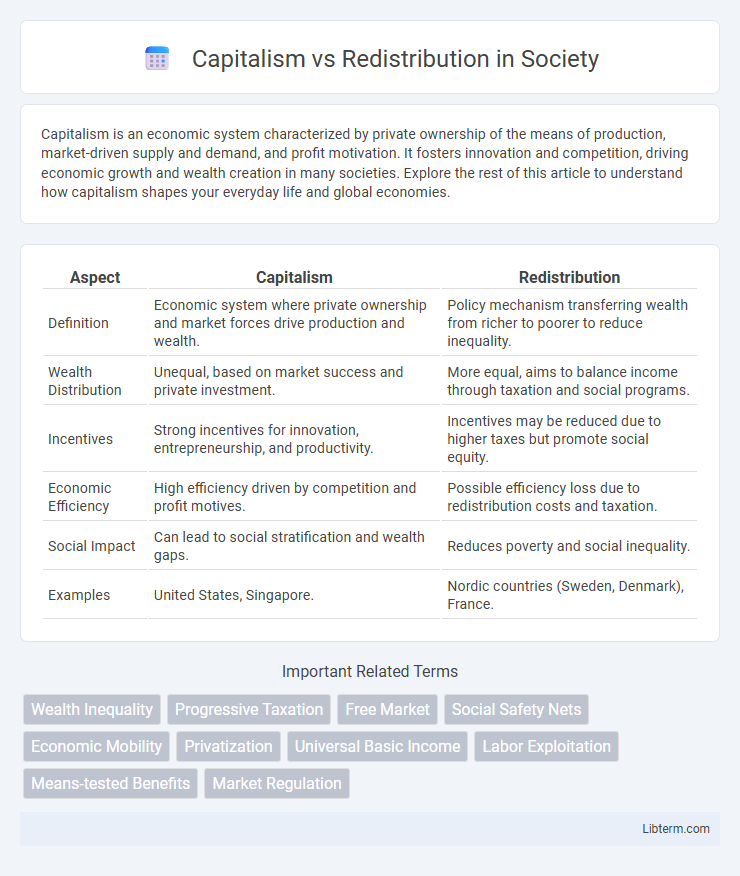Capitalism is an economic system characterized by private ownership of the means of production, market-driven supply and demand, and profit motivation. It fosters innovation and competition, driving economic growth and wealth creation in many societies. Explore the rest of this article to understand how capitalism shapes your everyday life and global economies.
Table of Comparison
| Aspect | Capitalism | Redistribution |
|---|---|---|
| Definition | Economic system where private ownership and market forces drive production and wealth. | Policy mechanism transferring wealth from richer to poorer to reduce inequality. |
| Wealth Distribution | Unequal, based on market success and private investment. | More equal, aims to balance income through taxation and social programs. |
| Incentives | Strong incentives for innovation, entrepreneurship, and productivity. | Incentives may be reduced due to higher taxes but promote social equity. |
| Economic Efficiency | High efficiency driven by competition and profit motives. | Possible efficiency loss due to redistribution costs and taxation. |
| Social Impact | Can lead to social stratification and wealth gaps. | Reduces poverty and social inequality. |
| Examples | United States, Singapore. | Nordic countries (Sweden, Denmark), France. |
Understanding Capitalism: Core Principles
Capitalism is an economic system characterized by private ownership of the means of production, market-driven resource allocation, and profit motivation. Core principles include competition, voluntary exchange, and minimal government intervention, which together stimulate innovation and economic growth. Understanding these elements is essential to analyzing the efficacy of capitalism compared to redistribution policies in addressing wealth inequality.
The Foundations of Redistribution
The foundations of redistribution in economic policy are rooted in principles of equity and social welfare, aiming to reduce income inequality through mechanisms such as progressive taxation and social safety nets. Capitalism drives wealth creation through market competition and private ownership, often resulting in unequal wealth distribution that necessitates governmental intervention. Effective redistribution policies balance incentivizing economic growth with providing support to marginalized populations to ensure social stability and economic inclusivity.
Historical Evolution of Both Systems
Capitalism evolved during the Industrial Revolution, emphasizing private ownership, market competition, and profit maximization, which spurred rapid economic growth and technological innovation. Redistribution policies emerged from social movements and political reforms in the 19th and 20th centuries to address income inequality through taxation, social welfare programs, and public services. The historical evolution of both systems reflects ongoing tensions between wealth accumulation and social equity, shaping modern economic and political landscapes worldwide.
Economic Growth in Capitalist vs Redistributive Models
Capitalist models typically drive stronger economic growth by incentivizing innovation, investment, and productivity through market competition and private ownership. Redistribution policies, while promoting social equity and reducing poverty, can sometimes dampen growth by increasing taxation and reducing incentives for entrepreneurship. Empirical studies show that moderate redistribution can coexist with growth, but excessive redistribution often results in slower economic expansion and reduced capital accumulation.
Income Inequality: A Comparative Analysis
Income inequality under capitalism often results from market-driven disparities in wages and wealth accumulation, where capital ownership significantly influences income distribution. Redistribution policies, such as progressive taxation and social welfare programs, aim to mitigate these inequalities by reallocating resources to lower-income groups, thereby promoting economic equity. Empirical studies show that countries with comprehensive redistribution mechanisms tend to have lower income inequality indices, highlighting the impact of policy intervention on economic disparities.
Social Mobility: Opportunities and Barriers
Capitalism promotes social mobility by rewarding innovation and entrepreneurship, creating opportunities for individuals to improve their economic status through merit and market participation. Redistribution policies aim to reduce barriers by providing equal access to education, healthcare, and social safety nets, which can enhance upward mobility for disadvantaged groups. However, excessive redistribution may reduce incentives for wealth creation, potentially limiting long-term social mobility and economic growth.
Government Intervention: Limits and Necessities
Government intervention in capitalism addresses market failures, redistributing wealth to reduce inequality and fund public goods such as education and healthcare. Limits arise from risks of inefficiency, bureaucratic overhead, and potential stifling of innovation, requiring a balanced approach to regulation and market freedom. Effective policies leverage targeted redistribution measures like progressive taxation and social safety nets to ensure economic stability while maintaining incentives for growth.
Global Case Studies: Successes and Failures
Capitalism drives economic growth through private ownership and market competition, shown by the U.S. and Singapore's high GDP per capita growth and innovation rates. Redistribution policies in Scandinavian countries like Sweden and Denmark demonstrate success in reducing income inequality and improving social welfare while maintaining strong economic performance. Conversely, Venezuela's heavy redistribution efforts fueled by oil revenue illustrate failures, leading to hyperinflation, economic contraction, and widespread poverty.
Public Perception and Societal Impacts
Public perception of capitalism often centers on its promotion of innovation, economic growth, and individual opportunity, while concerns about income inequality and social mobility persist. Redistribution policies garner support for reducing poverty and enhancing social welfare but face criticism related to potential disincentives for productivity and economic efficiency. Societal impacts of capitalism include dynamic market economies and wealth creation, whereas redistribution efforts aim to achieve social equity and mitigate disparities in access to resources and services.
Future Prospects: Striking a Balance
Future prospects of capitalism versus redistribution hinge on achieving a balance that fosters economic growth while ensuring social equity. Innovations in technology and policy reforms could enable wealth generation alongside targeted redistribution mechanisms such as universal basic income and progressive taxation. Sustainable economic models integrating environmental and social governance principles are critical to harmonizing market efficiency with equitable resource allocation.
Capitalism Infographic

 libterm.com
libterm.com